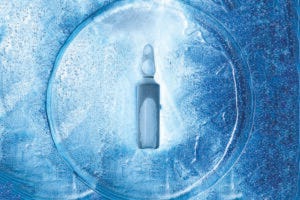Water-Proton Nuclear Magnetic Resonance Spectroscopy: Emerging Applications for Vaccine Quality AssessmentWater-Proton Nuclear Magnetic Resonance Spectroscopy: Emerging Applications for Vaccine Quality Assessment

Liquid-formulation vaccines often require shipment and storage within a temperature-controlled supply chain (a cold chain) between manufacture and administration. Since 2020, mRNA vaccines against SARS-CoV-2 have received considerable attention for their extreme cold-chain specifications. For instance, Pfizer–BioNTech’s Comirnaty bivalent booster for adults and adolescents must be stored in specialized freezers set between –90 C and –60 C for as long as 18 months (1). Usually, however, vaccines are shipped and stored in conditions between 2 C and 8 C (the temperature range measured during accelerated and long-term product-stability studies) because of their susceptibility to degradation and aggregation upon freezing (2). That is particularly true for aluminum-adjuvanted products, including many vaccines that are listed on recommended pediatric inoculation schedules (3). Such problems can decrease vaccine potency, raise unwanted immunogenicity concerns, and compromise patient safety.
Freezing events occur more frequently than we might expect. Based on a systematic review of studies on vaccine cold chains, Matthias et al. determined in 2007 that accidental freezing was pervasive across the supply chain. Between 14% and 35% of studied shipments were exposed to zero- or subzero-degree temperatures during transport, and 75–100% of lots experienced freezing conditions at some point during distribution (4). Despite mitigation strategies such as continuous temperature monitoring, rates of accidental freezing have not changed substantially. In 2017, Hanson et al. followed up on the Matthias team’s conclusions and found that in developed countries, 33% and 38% of vaccines experienced freezing during storage and transport, respectively. In low-income countries, products were exposed at similar rates during storage (37.1%), but only 19.3% of reviewed vaccine lots froze during transport (5). Thus, much work remains to protect vaccine quality and safety between manufacturing and administration.
As I learned from Marc B. Taraban, a research assistant professor of pharmaceutical sciences at the University of Maryland School of Pharmacy, part of the difficulty lies in the biopharmaceutical industry’s lack of straightforward, nondestructive analytical methods that can be applied for quality assurance and control (QA/QC) during and after product release. Taraban uses nuclear magnetic resonance (NMR) and other biophysical analytical methods to study structural biopharmaceutical characteristics and conformational dynamics. When I met him at the American Association of Pharmaceutical Sciences (AAPS) National Biotechnology Conference in May 2022, Taraban had presented about water-proton NMR (wNMR) as a nondestructive method for detection of aggregates in finished monoclonal-antibody (MAb) drug products and for determination of empty/full capsid ratios in gene therapies based on adenoassociated virus (AAV). In September 2022, Taraban spoke at the BioProcess International Conference and Exhibition, part of Biotech Week Boston, about their team’s development of a flow wNMR instrument with multiple biologic QA/QC applications, including rapid assessment of vaccines. I caught up with Taraban during the BPI event to learn more about the principles underlying wNMR and how they might be leveraged to facilitate vaccine QA/QC.
Basic NMR Principles
What are the principles underlying wNMR, and how might the method be useful for quality assessment of vaccines? The easiest way to describe wNMR is by analogy to magnetic resonance imaging (MRI). MRI scans do not capture images of your body per se; they are not images of lipids, proteins, organs, or bones. Rather, MRI maps out the relaxation time of water in those biological matrices. Relaxation time refers to the time needed for nuclear spins (e.g., of water protons) to return to equilibrium after excitation. The human body has abundant water content, and MRI can measure nuclear-spin interactions of water protons. Similarly, the underlying principle of wNMR is nuclear magnetic resonance relaxometry.
Generally, two relaxation times are used to describe when the magnetization of a particle’s nuclear spin returns its initial value (from before application of excitation pulses): longitudinal (T1) and latitudinal (or transverse) relaxation time (T2). Those values describe, respectively, spin–lattice and spin–spin interactions within a system. Because water is highly abundant in most biopharmaceutical formulations (usually ~90%), its parameters can be measured easily using straightforward, relatively inexpensive benchtop instruments. For instance, the flow wNMR magnet that we are developing is about the size of a shoebox.
In a biopharmaceutical formulation, water is in a permanent interaction with a solute. For example, water “senses” protein behavior through proton exchanges. If other kinds of particles are present in a solution — consider aluminum adjuvants in vaccine drug products — then the difference in magnetic susceptibility between the water and aluminum particles creates a disturbance around them, which also affects the water’s relaxation time.
Several mechanisms can affect water relaxation, including not only proton exchange and magnetic susceptibility contrast, but also agglomeration. For instance, when adjuvanted vaccines are frozen, aluminum particles cluster. Agglomeration also can occur in some nanoparticle formulations because of changes in concentration, buffer conditions, and/or pH. Such aggregates create compartments between clustered particles because they do not collapse together tightly. Water retained in such compartments has a different relaxation property than does water in other drug-product conditions.
Such differences can be detected using wNMR. The three mechanisms that I mentioned usually are intertwined because aluminum particle surfaces have hydroxyl groups that are interacting with water by proton exchange. But through such mechanisms, water senses molecular-level events that occur in a pharmaceutical formulation — e.g., changes in pH and concentration, aggregation, and (especially for vaccines) sedimentation stability and density.
Biopharmaceutical Applications
How are conventional NMR processes performed, and how does your team seek to leverage wNMR? The “standard” method is high-field, high-resolution NMR, which most often is used within a frequency domain. For a given sample, you obtain a spectrum of signals from all of its components — and most biopharmaceutical formulations are highly complex, with many components. Usually, such NMR methods involve transfer of samples into 5-mm glass tubes, and a deuterium standard often is needed for shimming and locking procedures — for optimizing the homogeneity of a magnetic field and compensating for its drift during measurements, respectively.
Such workflows can generate considerable information precisely about a sample. In structural biology, high-field, high-resolution NMR experiments generally are limited to assessments of molecular structure and relative concentrations of sample components. But measurements of a drug product and/or dosage unit are not possible because high-field, high-resolution NMR instruments are not designed to measure entire vials. For instance, our laboratory has among its tools a powerful 900-mHz NMR instrument that works with 3-mm and 5-mm tubes. Of course, by extracting and analyzing material from a vial, you can gather diverse information. But doing so makes a drug product unusable. We intend to leverage the fact that NMR can give “binary” answers to QA/QC questions — e.g., should we discard this vial? — and we are developing wNMR technology that can analyze an entire vial without extracting material from it. As with MRI, the method is noninvasive. We just need an instrument that is designed to handle samples aside from those loaded into glass tubes.
How might wNMR be applied in industry? Would it be useful primarily for postrelease testing of vaccines? We are considering several potential applications. We have developed a flow wNMR technology that can monitor changes in concentration, pH, and aggregate content in a process without extracting material from the flowpath. The device simply measures water relaxation rate over time. That capability could be helpful during continuous biomanufacturing (6).
But postrelease testing of vaccine products is a particularly useful application. Our team recently published a paper based on the provocative premise that all vials are not the same (7). Current release-testing methods assume that all vials from a given batch are identical in composition. Usually, a few vials are taken at random from a batch, and those materials undergo tests based on common analytical technologies, including high-performance liquid chromatography (HPLC), mass spectrometry (MS), and Raman and near-infrared (NIR) spectroscopies. The industry uses multiple technologies, many of which are based on optical methods. But most of those are invasive, requiring removal of a drug product from its vial. Because wNMR is not an optimal method, you would not need to do that, and you should not be hampered by product labels. Vaccine vials can remain capped during analysis. Aluminum caps are nonmagnetic, so they would not interfere with measurement.
Another potential application relates to formulation. Drug companies devote considerable resources to formulation testing, including stability studies. HPLC runs require many expensive materials such as buffers and columns in addition to costs for labor and instrument time. Using a relatively inexpensive system for wNMR, you can easily determine which formulations will not work (e.g., because of instability concerns) and then discard them. In such cases, scientists might not need to perform deep analyses based on HPLC, size-exclusion chromatography (SEC), microflow imaging, dynamic light scattering (DLS), or calorimetry. A wNMR technology would enable formulation scientists to test vials — without opening them — to identify and discard product batches that are definitely out of range and represent a “dead end.”
That seems to be a good example of wNMR’s ability to answer binary questions. That is just the kind of case we are interested in. Of course, if you discover that a batch of products became compromised, you can determine what happened by opening some vials and performing a more precise, invasive analytical method. For instance, MS or high-field NMR can be applied to measure whether product concentrations fall within specifications. Such testing can be useful for the rest of the biopharmaceutical industry, too, in helping scientists to understand what happened with a given batch of drug products. But during final release testing, for instance, the goal is to prevent bad products from being sent to patients; that is why companies establish strict QC settings. For such testing, a simple use-or-discard answer suffices.
What other kinds of data can wNMR methods obtain, and what other kinds of binary answers might they provide? One kind of measurement can be broadly revealing. Generally, a single relaxation-rate measurement taken from a vaccine drug product can be compared with values from a product that is known to be of high quality. You will be able to tell immediately if the water relaxation rates of the products differ, and significant differences would mean that the vial being tested has a problem.
Another possibility is to leverage multivariate NMR. For instance, sedimentation rates can be measured in adjuvanted vaccine products by obtaining water relaxation rates from a vial’s supernatant and sediment. Over time, concentrations of aluminum particles increase in the bottom of a vial and decrease toward the top. Thus, those parts of a vial will exhibit different water-relaxation values. Sedimentation rate can be deduced from those differences. This parameter is important for vaccine formulation because it indicates a formulation’s stability. Through such studies, you also can obtain sedimentation-volume ratios (SVRs), which indicate the relationship between sediment thickness and total sample height. SVR is another critical parameter for vaccine formulation because it indicates the possibility of resuspension before injection into a patient. Dense vaccine products will be difficult to resuspend after they have been sitting in the refrigerator for, say, several months.
Essentially, wNMR could enable scientists to gather important data about vaccine stability and resuspension potential without looking at a vial. Currently, the biopharmaceutical industry uses multiple instruments and methods to obtain SVR and other kinetics measurements. Often, such methods necessitate transfer of drug-product samples to other facilities for testing — e.g., because optical tests sometimes require cuvettes with specific transparency characteristics. Optical methods are effective technologies; they provide precise results reliably. But they generally require transfer for analysis. Our team is developing a wNMR technology that can use drug-product vials to take required measurements, even at small volumes. Consider that some analytical technologies require no less than 1 mL of material for testing and that some vaccines come in 0.5-mL vials.
Scientists also can obtain interesting results by using wNMR to scan and monitor particular parameters of a pulse sequence used to analyze the relaxation of certain formulation. Sometimes those parameters can serve as a “fingerprint,” or a value that is characteristic of a particular formulation. So rather than scanning for just a single value, you can identify unique or interdependent values, then compare those with data from substandard formulations — e.g., material that has experienced heating or shaking or that has frozen instead of remaining just above the point of freezing.
You mentioned aluminum-adjuvanted vaccines. Could wNMR work for nonadjuvanted vaccines, too? We believe that they can, but we have yet to explore that area fully. Such products usually contain complex mixtures of antigens and excipients. Measurements are much easier to take in adjuvanted vaccines because adjuvant concentration is a significant parameter. We also have shown that aluminum provides a strong response during wNMR analysis. Nonadjuvanted vaccines could be expected to produce lower responses. We still need to investigate whether and how the method could work for such products.
What would be needed to implement wNMR workflows in an industrial context? System automation, including perhaps built-in artificial intelligence (AI) capabilities, would be a significant benefit. Measurements can be taken quickly. Most formulations can be analyzed in several seconds. For instance, because aluminum produces a high response in wNMR, specifically in the tool that we have developed, aluminum-adjuvanted vaccines can be analyzed in 10 to 15 seconds. Special formulations might require close to a minute per vial. But some degree of automation is needed for placing vials in the instrument and taking them out after analysis, or you might envision something like a conveyor belt, on which vials will approach the NMR magnet and be measured as they appear. An AI program could be leveraged to identify substandard, out-of-specification vials and discard them from the conveyor belt.
A wNMR system could fit seamlessly into final-release testing and continuous biomanufacturing settings. The system that we have developed could be integrated easily within existing production-monitoring platforms. The flow NMR magnet would be used to detect abnormalities such as changes in concentration or flow rate.
How might wNMR be applied to biopharmaceutical modalities besides vaccines? We have made interesting observations about gene-therapy products while using our technology. We found that water interacts differently with empty and full capsids of AAV (8). Perhaps water diffuses into empty capsids, or maybe water molecules are more tightly bound when a transgene is inside the AAV capsid. Generally, though, samples with filled and empty capsids show extremely different transverse-relaxation rates when analyzed for commonly used concentrations of viral genomes per milliliter. Using AAV serotype 9 containing a full transgene with a cytomegalovirus–green fluorescent protein (CMV-GFP) cassette, we analyzed the water relaxation rates of samples with 100% full capsids, 100% empty capsids, and different mixtures thereof to create something akin to a titration curve. It was perfectly linear, indicating that the relaxation rate of water showed a perfectly linear dependence on the empty/full capsid ratio. Our measurements exhibited high sensitivity and good precision, enabling us to estimate empty/full capsid ratios in the gene-therapy products precisely and noninvasively.
That capability of wNMR could be important for several stages of gene therapy production. The technology could be particularly useful for final QA/QC steps. For the moment, it is difficult to envision that drug companies will be producing gene-therapy products in million-dose batches. Given the relatively low number of doses that are produced, final QA/QC steps based on wNMR could be performed manually. The technology works quickly, and vials do not need to be opened or compromised for analysis.
What other aspects of wNMR is your team exploring? We are evaluating the method’s utility for analysis of insulin products in injector pens. That application could be critically important for the biopharmaceutical industry and for healthcare more generally. We already have published papers that describe wNMR analysis of insulin products inside their pens without extracting any of their contents (e.g., 9).
We continue to explore applications such as QA/QC of antibody formulations. About five years ago, our team wrote about that topic in conjunction with scientists from MedImmune (now part of AstraZeneca) (10). We are developing our flow NMR technology to accommodate multiparametric studies, and we are determining how useful such capabilities would be for the biopharmaceutical industry and further research.
What do you hope that wNMR technology will accomplish for the biopharmaceutical industry? We hope that it will simplify research and development (R&D) work, especially by saving time and resources during formulation testing and stability studies.
When our team has interacted with the biopharmaceutical industry, scientists and company leaders almost always have asked what our technology will replace. But that is the wrong question to ask. We are not eliminating anything by advancing wNMR. The method will not replace HPLC, MS, calorimetry, or microflow imaging; it also will not replace methods for in-depth characterization. Rather, we are trying to help scientists by suggesting a complementary technology that could simplify their work. The technology would be most beneficial when users need to answer a yes–no question. That capability would be most important during final release testing and perhaps even at the point of care. Currently, clinicians have no way to perform such QA/QC analyses at the point of care. We are thinking about ways to design wNMR instrumentation for analysis of vials just before administration. I believe that such technologies will increase society’s confidence in the biomanufacturing industry.
What methods do clinicians currently use for point-of-care vaccine QC? One example is the World Health Organization (WHO) “shake test” for detection of freezing damage to vaccines (11). Imagine that you are receiving a vaccine shipment from a refrigerated transport. The temperature monitor indicates that the lot has dropped to temperatures below 0 °C. The WHO protocol requires that you compare a vial from the suspicious lot with a vial known to be free of freezing damage. The undamaged vial is frozen so that it can serve as a control. Then, both vials are brought to ambient temperature, their labels are peeled off to reveal their contents, and they are shaken. If after five to 15 minutes the vials exhibit the same kind of sedimentation, then according to the protocol, you should assume that the vial in question experienced freezing and is damaged.
The shake test is problematic for a few reasons. Clinicians cannot test every vial in a lot. Vaccine vials holding 0.5 mL might not have enough material for healthcare workers to see evidence of sedimentation. Peeling off product labels raises other concerns. Such factors make the WHO tests infeasible in the field.
Our team also has found that vaccines do not always freeze at 0 °C or slightly subzero temperatures. Some vials freeze, but others do not because of slight differences in storage conditions and product homogeneity. Vials that have not frozen might be good enough to administer. But if you follow the shake test, entire lots of vaccine must be discarded if one vial shows evidence of freezing damage. That results in significant wastage of vaccine drug product. Our technology enables users to tell whether a particular vial has experienced freezing. The water relaxation rate of a previously frozen vial will be significantly different from that of a vaccine that is free from freezing damage. That is a good example of what wNMR data can provide.
References
1 Pfizer-BioNTech COVID-19 Vaccines. US Food and Drug Administration: Silver Spring, MD, 8 December 2022; https://www.fda.gov/emergency-preparedness-and-response/coronavirus-disease-2019-covid-19/pfizer-biontech-covid-19-vaccines#additional.
2 ICH Q1A(R2). Stability Testing of New Drug Substances and Products. European Medicines Agency: Amsterdam, The Netherlands, 2003; https://www.ema.europa.eu/en/ich-q1a-r2-stability-testing-new-drug-substances-drug-products-scientific-guideline.
3 Milstien J, Kartoglu Ü, Zaffran M. Temperature Sensitivity of Vaccines. World Health Organization: Geneva, Switzerland, 2014; https://cdn.who.int/media/docs/default-source/immunization/supply-chain/temperature-sensitivity-of-vaccines.pdf?sfvrsn=d1a6e207_7&download=true.
4 Matthias DM, et al. Freezing Temperatures in the Vaccine Cold Chain: A Systematic Literature Review. Vaccine 25(20) 2007: 3980–3986; https://doi.org/10.1016/j.vaccine.2007.02.052.
5 Hanson CM. Is Freezing in the Vaccine Cold Chain an Ongoing Issue? A Literature Review. Vaccine 35(17) 2017: 2127–2133; https://doi.org/10.1016/j.vaccine.2016.09.070.
6 Taraban MB, et al. Flow Water Proton NMR: In-Line Process Analytical Technology for Continuous Biomanufacturing. Anal. Chem. 91(21) 2019: 13538–13546; https://doi.org/10.1021/acs.analchem.9b02622.
7 Yu YB, Taraban MB, Briggs KT. All Vials Are Not the Same: Potential Role of Vaccine Quality in Vaccine Adverse Reactions. Vaccine 39(45) 2021: 6565–6569; https://doi.org/10.1016/j.vaccine.2021.09.065.
8 Taraban MB, Jones MT, Yu YB. Rapid and Noninvasive Quantification of Capsid Gene Filling Level Using Water Proton Nuclear Magnetic Resonance. Anal. Chem. 93(48) 2021: 15816–15820; https://doi.org/10.1021/acs.analchem.1c04088.
9 Taraban MB, et al. Inspecting Insulin Products Using Water Proton NMR: Noninvasive Versus Invasive Inspection. J. Diabetes Sci. Technol. 16(6) 2021: 1410–1418; https://doi.org/10.1177/19322968211023806.
10 Taraban MB, et al. Water Proton NMR: A Tool for Protein Aggregation Characterization. Anal. Chem. 89(10) 2017: 5494–5502; https://doi.org/10.1021/acs.analchem.7b00464.
11 Kartoglu Ü, et al. Validation of the Shake Test for Detecting Freeze Damage to Adsorbed Vaccines. Bull. World Health Organ. 88, 2010: 624–631; https://doi.org/10.2471/BLT.08.056879.
Brian Gazaille is managing editor of BioProcess International, part of Informa Connect; [email protected]; 1-212-600-3594. Marc B. Taraban is research assistant professor at the University of Maryland School of Pharmacy, 9600 Gudelsky Drive, Rockville, MD 20850; 1-240-314-6156; [email protected].
You May Also Like




.jpg?width=700&auto=webp&quality=80&disable=upscale)

